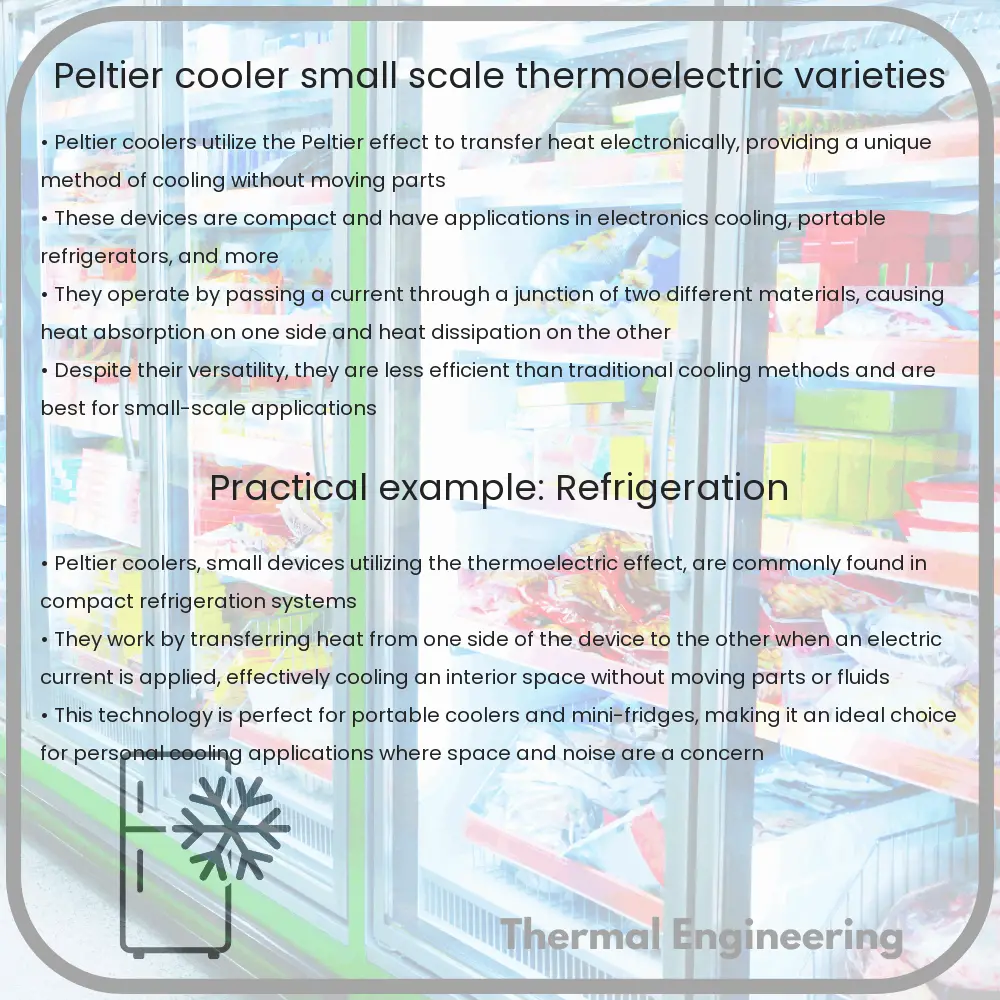Learn about Peltier coolers, small devices using the thermoelectric effect for efficient heat transfer in compact applications.

Understanding Peltier Coolers: A Look at Small-Scale Thermoelectric Varieties
Peltier coolers, also known as thermoelectric coolers (TECs), offer a fascinating application of thermoelectric effect to achieve heat transfer. These devices are increasingly utilized in various applications where traditional cooling systems are impractical. This article explores the basics of Peltier coolers, focusing on their operation, design, and common small-scale applications.
How Peltier Coolers Work
Peltier coolers work on the principle of the Peltier effect, discovered by Jean Charles Athanase Peltier in 1834. The Peltier effect causes heating or cooling at an electrified junction of two different conductors. When a current flows through the junction of two different types of materials, heat is absorbed at one junction (cooling it) and released at the opposite junction (heating it), creating a temperature difference.
The basic components of a Peltier cooler include:
- Thermoelectric modules: These are typically made up of many pairs of p- and n-type semiconductor material that create a circuit of multiple thermocouples.
- Ceramic plates: They sandwich the thermoelectric modules to enhance durability and provide insulation.
- Heat sinks: Attached to both sides of the thermoelectric modules to dissipate heat effectively from the hot side and absorb heat from the cool side.
The most critical aspect of TEC operation is the direction of current flow, which determines which side of the cooler will be hot and which will be cold.
Mathematical Model of Peltier Coolers
The performance of Peltier coolers can be estimated using several equations, taking into account the properties of the materials and the operational conditions. The key parameters include:
- Seebeck Coefficient (S): This relates to the voltage developed per unit temperature difference across the thermoelectric material.
- Thermal Conductivity (k): Measures the ability of a material to conduct heat.
- Electrical Resistance (R): Affects the current flow through the cooler.
The basic effectiveness of a Peltier cooler can be calculated by the equation Q = (SAB – SCD) * I * T, where SA and SC are the Seebeck coefficients of materials, I is the current, and T is the absolute temperature difference.
Applications of Small-Scale Thermoelectric Coolers
Due to their compact size and lack of moving parts, small-scale Peltier coolers are ideal for applications where space and reliability are critical. Some common applications include:
- Consumer Electronics: Used in portable refrigerators, wine coolers, and to cool electronic components such as CPUs and lasers in compact devices.
- Medical Devices: Used for localized temperature control in medical storage units and to maintain precise temperatures in devices such as DNA replication machines.
- Automotive Applications: Employed in car seats for heating or cooling and in luxury vehicle cup holders to keep beverages hot or cold.
Challenges and Limitations
While Peltier coolers offer significant advantages in terms of size and mechanical simplicity, they also have limitations, including:
- Energy Efficiency: Peltier coolers are generally less energy efficient compared to conventional cooling methods such as refrigeration cycles, particularly at larger scales.
- Heat Dissipation: The requirement for good heat sinks and the challenge of dissipating large amounts of heat can limit their effectiveness.
- Cost: The cost of high-performance thermoelectric materials can be a barrier for some applications.
In conclusion, small-scale Peltier coolers provide unique solutions for compact and precise cooling needs but require careful consideration of their characteristics and limitations in real-world applications. Ongoing research and development in material science may further enhance their performance and expand their use in the future.